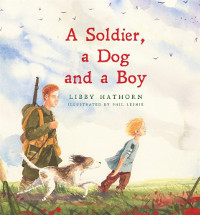A soldier, a dog and a boy by Libby Hathorn

Ill. by Phil Lesnie. Lothian Children's Books, 2016. ISBN
9780734416377
(Age: 7+) Recommended. Animals in war. Children in war. War. Dogs.
Refugees. Fighting at the Somme in Northern France during World War
One, a young Australian soldier spies a stray dog, and adopts it,
promising it will eat grandly: bully beef bourguignon. He tries to
do some tricks with the animal, but the sad-face dog does not
understand him. They walk on together, the young man wanting to adopt
him as his company's mascot. In the background the luminous
illustrations reveal aspects of the war in which the young man and
his fellow Anzacs are involved. Eventually a young boy approaches
them and he tells the soldier that the dog is his. He is able to get
the dog to do the tricks the soldier tried, but when the soldier
suggests the boy go to an orphanage he realises that he must sleep
rough, the dog by his side, as the orphanage will not allow a dog.
The soldier asks the boy if he can have the dog, but the boy
refuses. The soldier then gives the boy money for the two of them
and bids them farewell. As we see the soldier moving off through the
field of red poppies, the boy chases after him, exhorting him to
take the dog back to Australia. So the soldier walks off with the
dog wrapped around his shoulders. But this is not the end. The end
of the story will make readers think hard about what happened to the
other children like this one, what happened to the animals involved
in war, as well as the story of a young boy smuggled back to
Australia, which actually happened.
Hathorn's research into her own family's history at Gallipoli gave
rise to this story, and the illustrations by Lesnie give an
incredible back drop to the tale. Readers will gain some insight
into the effect of war on the landscape, as well as the populace and
feel some of the privations felt by the soldiers through the
illustrations. The names given to the dogs by the two will engage
the attention of the reader, and they will be able to think about
some of the words associated with World War One.
This is an interesting and thought-provoking addition to the
collection of picture books about Australia's participation in war
which have appeared in the last few years and will be a wonderful
inclusion for any library, classroom or home.
Fran Knight